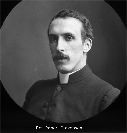



The Church is the oldest institution in the village, having been here in one form or another since well before 1500. When the structure had become ruinous by the end of the 1500s it was replaced in the 1620s then later rebuilt (or more likely renovated, the records are silent on which) in 1774, thus taking on the appearance seen today. The last substantial renovation was an internal one in 1891 although there have been lesser ones since including a recent expensive re-
A modern, detailed Church History Booklet is available.
There are various items of historical interest connected with the church. The Session Minutes which commence in the early 1600s provide an interesting glimpse of church life through to the 1970s. These, and any other records more than 50 years old are required to be held in the Stirling Council Archives where they can be viewed by anyone.
Wading through these minutes can be tedious although on occasions rewarding (for instance I discovered in them an interesting 19th century skeleton in the McLaren family cupboard!). If your interest is more general than particular I would recommend reading an interesting paper called Glimpses of Church Life in Olden Days written in 1930 by a former minister who had taken the trouble to trawl through them all for a talk he gave to the Stirling Natural History & Archaeological Society.
His paper not only covers the Session minutes but also the 270+ years old handwritten diary of another former minister here, the Rev John Warden, covering the period 1734 to 1745. Reading through Warden’s diary would have been a real labour of love as it is extremely difficult to decipher (see left) His handwriting is poor, his spelling is unusual and his punctuation interesting.
Other ministers throughout the years were required to prepare Statistical Accounts of the Parish and although the name is a bit off-
For a map of the old kirkyard, an alphabetical list of surnames in monumental inscriptions and an index to thousands of names and places in the old local Church magazines visit the Genealogy Tab.









Church History

The three linked Parishes of Gargunnock, Blairdrummond and Doune were successful in 2011 in seeking a new minister, the Rev Andy Campbell. In connection with this a Parish Profile document was prepared for interested applicants giving a detailed overview of the three churches and parishes. Rev Campbell eventually retired and due to the national shortage of ministers, reduced numbers of candidates for ministry and impending retirements a comprehensive review of the situation was undertaken resulting, locally, in a new set-
While a new minister nowadays is chosen democratically by the congregation it wasn’t always that way. Up to the mid 1800s the Heritors of the Parish chose a new minister. For instance documents retained here dated 1809 show Mr James Eidingtoun, Heritor of Gargunnock Estate, exercising his right to present a new minister, Rev Alexander Davidson to the Presbytery as minister for Gargunnock. This became ever more unacceptible to the ordinary membership and pressure built up for them to win that right. They eventually did and the first minister to be appointed here wholly by the membership was Rev Robert Stevenson in 1888.
Stevenson was a gifted man, related through his grandfather not only to the famous lighthouse and bridge designers & builders but also to Robert Louis Stevenson the famous writer. A wealthy man too he extended the manse, provided the village with a piped water supply and was a major financial contributor to the creation of a church hall in 1939, all at his own expense. He remained here from 1888 to his retirement in 1927 but continued his association with the Parish up to his death, in Melrose, in 1947.


| History Bytes |
| Statistical Accounts |
| Church History |
| Local Magazines |
| Chronology |
| Parish Magazines |
| Kirkyard Monumental Inscriptions |
| Lower Graveyard Monumental Inscriptions |
| Where are they now? |